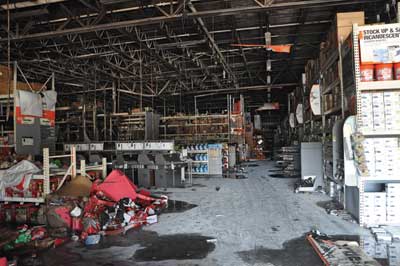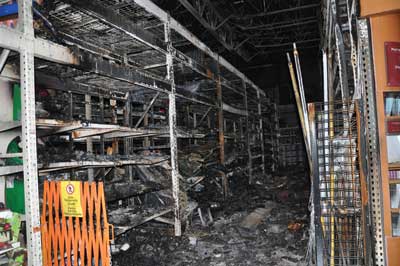BY BILL GUSTIN
Automatic sprinklers do not guarantee that a building will not have a dangerous, destructive fire that is difficult to control. This is an important lesson Miami-Dade County (FL) firefighters learned or had reinforced when an arsonist allegedly set a fire in the paint department of a Home Depot store in the southern portion of the county. This fire was a perfect example of why it is essential to support a sprinkler system by ensuring that control valves are open, building fire pumps are operating, and fire department apparatus pump into fire department connections (FDCs) as soon as possible. Pumping into FDCs gives sprinklers their best shot at controlling a fire; this is important at any fire at a sprinklered occupancy, but it is critical if the fire pumps fail to operate or pump sufficient water or if water flow demand exceeds sprinkler system design.
Murphy’s Law was in full effect when this fire occurred: A fire suppression system contractor had closed sprinkler riser control valves to perform maintenance on the system. It took approximately five minutes for the contractor to open the valves after he was aware of the fire, but this was not fast enough to stop the fire from spreading to several feet of merchandise racks containing flammable and combustible paint, solvents, and aerosols and activating far more sprinkler heads than the system was hydraulically designed to control in a fire involving these commodities (photos 1-3). Two engines, each pumping two three-inch hoselines into FDCs, significantly increased the supply of water, but with so many sprinkler heads activated, it was a fraction of the water flow necessary to allow the sprinkler system to operate at its designed capability (photo 4). The fire’s extremely high heat release rate, the rapidly deteriorating conditions, and structural instability forced the companies advancing the hoselines to withdraw from the building and implement a defensive strategy. It took more than three hours for the crippled sprinkler system to bring the fire under control.
The Building
The 100,849-square-foot building, constructed in 2007, was of concrete tilt-up wall construction built on a poured concrete slab. The building was a typical Type 2-noncombustible “big box” store. It had a corrugated metal deck roof supported by open web and unprotected steel bar joists spaced five feet on center and spanning 45 feet. The bar joists were supported by exterior tilt-up walls and girder trusses, which also spanned 45 feet, supported by steel “H” columns spaced 45 feet on center throughout the interior of the building. The girder trusses, which were massive in comparison to the bar joists they supported, initially expanded and then distorted when they were heated by this rapidly developing fire (photos 5-6). When the girder trusses distorted, they exerted a lateral thrust on the bar joists that were bearing on the building’s front (A side) wall with sufficient force to push it out of plumb and separate it at its joint with the south B wall, creating a gap of several inches (photo 7). Subsequently, the bar joists exposed to extreme heat lost their tensile strength and began to sag, pulling the A and B walls back together. It is remarkable to note that the separation of the walls in the A/B corner occurred within 15 minutes of the initial commercial building fire dispatch; it is indicative of the tremendous heat release rate of the merchandise burning on the racks in the paint department.
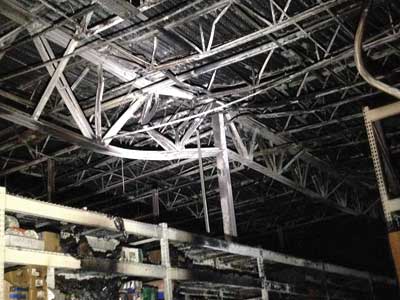 |
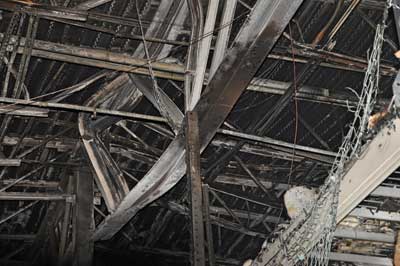 |
| (5-6) One of the girder trusses distorted by the extremely high heat release fire. The distorted girder trusses exerted sufficient horizontal force on the bar joists they supported to push out the A tilt wall. |
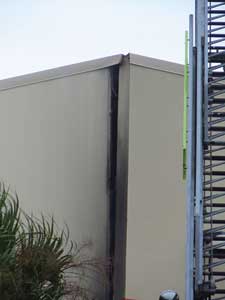 |
| (7)This gap in the A/B corner of tilt walls was caused by the distortion of the girder truss, which exerted a thrust on the bar joists, pushing out a section of the A wall. |
Fire Protection
The building’s sprinkler system and fire hydrants located on all sides of the building were supplied by a 10-inch main that received water from two directions-from the east through a 12-inch main on SW 137th Avenue and from the south through parallel eight- and 12-inch mains on SW 288th Street. The building had a vertical shaft fire pump driven by a 125-horsepower electric motor. The fire pump delivered 500 gallons per minute (gpm) at 90 pounds per square inch (psi). Piping for the two FDCs was connected on the discharge side of the fire pump.
This is a standard configuration, so when pressure developed by fire apparatus pumping FDCs exceeds the pressure developed by the fire pump, a clapper valve in the pump’s discharge piping closes. This cuts off the flow from the fire pump, and the FDCs become the sole source of water for the system. In this system, piping for the FDCs is connected to the inlet or supply side of the riser control valves. This is a standard piping configuration for multiple-riser systems. It allows flow from FDCs to be cut off for an individual riser while the FDCs continue to supply the other risers. This configuration prevents firefighters from wasting water when they “write off” a section of a fire building or when sprinkler piping is leaking water because of damage from an explosion or a building collapse.
There is, however, a drawback to this configuration: The FDCs cannot bypass riser-control valves closed by an arsonist or prematurely closed by building maintenance personnel. Conversely, single-riser systems have FDCs plumbed on the system side of the control valve and can be bypassed by FDCs if the valve is closed.
This store had 13 hose stations connected to the sprinkler system with two-inch pipe. Employees or firefighters did not use them at this fire. It is highly recommended that you stretch hose from apparatus instead of using hose stations inside big box buildings so that when you exit, you can follow the hoseline that leads to the apparatus outside of the building. Conversely, firefighters operating from a hose station will follow a hoseline that leads to the valve, which can be a considerable distance from the means of egress. Additionally, hose stations generally do not flow sufficient water to fight anything larger than a small, incipient fire and may result in a delayed alarm if employees attempt to fight a fire before calling 911.
Home improvement stores have requirements for storage of merchandise on racks. For example, shelves may have to be wire mesh unless sprinklers are in the racks. When wood slats are used for shelves, they cannot exceed a specific width, and the spacing between the slats must be a minimum of two inches apart. The open-grid shelves and the gap between the slats allow heat from a fire to convect upward to activate sprinklers overhead and the water flowing from the sprinklers to cascade downward to lower shelves. Racks may be required to have draft curtains at specified intervals to limit the horizontal spread of fire (photo 8). Draft curtains also hasten the activation of sprinklers closest to the fire by creating a flue of a specified width, which concentrates the heat rising to the sprinklers overhead. They also limit the lateral spread of heat, which would otherwise activate too many sprinkler heads.
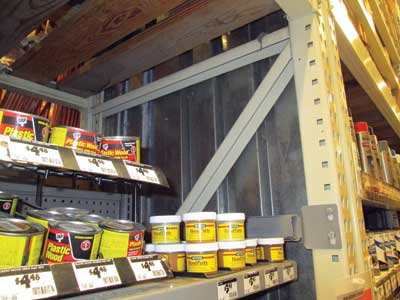 |
| (8) The gap between the slats allowed heat from the fire to convect upward to activate the sprinklers overhead and allow water flowing from sprinklers to cascade downward to the lower shelves. Draft curtains in the racks limited the horizontal spread of fire and hastened the activation of the sprinklers closest to the fire by creating a flue that concentrated the heat rising to the overhead sprinklers and limited the lateral spread of heat, which could result in activating too many sprinkler heads. |
The sprinkler system was hydraulically designed to control a fire based on the fire load of the commodity stored in specific areas or departments in the store. For example, overhead sprinklers in areas containing flammable liquids, aerosols, and polystyrenes were designed for a discharge density of 0.6 gpm per square foot; that’s like having a firefighter with a booster line flowing 60 gpm every 100 square feet. In comparison, most residential sprinkler systems are designed for a discharge density of 0.1 gpm/square foot. The paint department was protected by extended coverage upright ceiling sprinklers with a “k factor” of 25, designed for high heat-release fires in storage areas. The sprinkler heads, which activate at 214˚F, can flow as much as 100 gpm per head. When only one head is activated, it can flow more than 200 gpm. Each sprinkler head was designed to protect a maximum of 196 square feet, and the system was designed to protect a maximum fire area of 2,000 square feet with a maximum of 12 heads flowing.
The sprinkler system design specifications beg the question: What if the size of the fire area exceeds 2,000 square feet? The answer is that it would result in activating more heads than the system was designed to supply. This would result in inadequate flow, in terms of gpm/square feet, which may fail to control a fire. This is precisely what occurred at this fire because the fire spread beyond the designed maximum coverage area before the sprinkler risers were reopened. Another factor that can result in opening too many sprinkler heads is the explosion and rocketing across the store of aerosol cans containing flammable or combustible liquids, spreading fire to other areas. This, however, was not a factor at this fire. In addition to overhead sprinklers, in the paint department, there were in-rack sprinklers with two branch lines supplying heads at six- and 111/2-foot levels (photo 9). The in-rack sprinklers, spaced nine feet on center, activated at 155˚F and were designed to discharge 30 gpm from each of the hydraulically most remote 12 sprinklers (six on each of two lines).
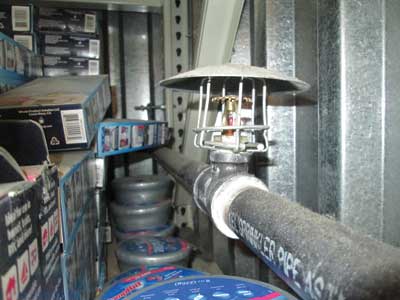 |
| (9) In-rack sprinkler and draft curtains. The water shield, mounted on top of the sprinkler head, is designed to prevent water from the sprinklers above from cooling it, delaying/preventing its activation. Draft curtains create a “flue” that concentrates heat to the overhead sprinklers and limits the lateral spread of heat from activating too many sprinkler heads. Note: Photos 8 and 9 were taken at a Home Depot that has a similar sprinkler design and storage configuration as the fire site. |
An Extended Operation
It took more than three hours for the sprinklers to have a positive effect on the fire; thick, black smoke gradually changed to thick, gray, steamy smoke. Unfortunately, the sprinklers had a negative effect on ventilation because they cooled the smoke to the point that it lost its buoyancy and would not lift. Before companies were sent back into the building for overhaul, the building had to be extensively ventilated. Every overhead door was either opened, when possible, or cut with a rotary saw, and every double sliding entrance door and swinging exit door was opened to vent the building of moist, dense, heavy smoke. Before interior overhaul, the building’s tilt wall and roof assembly were assessed to determine the risk of collapse and to establish interior and exterior collapse zones. Additionally, hazardous materials companies analyzed samples of runoff water mixed with paint and solvents that gushed out of the building and set up a decontamination station for companies when they exited the building.
Although it appeared that the sprinklers had the fire under control, it was still burning. The sprinklers were kept flowing to reduce the chances that the fire, which was involving large quantities of flammable and combustible liquids, would rapidly intensify. This made visibility more difficult and soaked personnel performing overhaul, but they were safer than if the sprinklers had been shut down. All personnel were withdrawn from the building when the sprinkler system was finally shut down. The overhaul operation was planned so that firefighters remained outside the interior collapse zone but were able to reach the fire area with a stream from a 2½-inch hoseline equipped with a 11⁄8-inch smooth bore tip. Similarly, personnel would not be permitted to operate in aisles between damaged racks, which could have collapsed.
Companies performing overhaul were to take the shortest, most direct path to the fire area and back to the means of egress; that would limit the number of personnel by minimizing the number of turns. A firefighter was to be positioned at each corner and friction point to keep the hoseline moving.
A critical consideration was that the path to the fire had to be outside the interior collapse zone. A rapid intervention crew stood by near the point of entry, as did an accountability officer, who wrote down entry times. This ensured that personnel would have a sufficient air supply to safely exit the building. The first entry, through the garden center at the B side of the building, was aborted when the overhaul group supervisor determined that companies advancing a 2½-inch hoseline would have to operate in the narrow aisle between the B wall and the ends of the racks in the paint department or advance their line parallel to them to operate at the other end of the racks. Consequently, personnel had to travel a considerable distance and had to turn a corner with their hoseline. A shorter and more direct entry was through the main entrance on the A side.
Lessons Learned/Reinforced
• Sprinkler systems have limitations. The size of sprinkler piping, the spacing of sprinkler heads, the gpm flow per head, and the number of heads expected to operate are all based on calculations of the heat produced by the commodity protected, the manner in which it is situated or stored, and the size of the anticipated fire area. Proper operation of a sprinkler system also depends on adequate minimum static and residual pressures. Change the commodity to one that produces more heat than the sprinkler system was designed for, increase the fire area, or reduce the pressure, and the system may fail to control a fire. Additionally, sprinklers, except deluge systems, are designed to control a fire in its beginning stages. At this incident, the fire was intentionally ignited while sprinkler riser control valves were closed. This allowed the fire to spread beyond the number of square feet the sprinklers were designed to protect. Once the valves were opened, water flowed from far more sprinkler heads than the system was designed to flow; consequently, pressure in the system dropped to a point that it was no longer effective. The lesson learned or reinforced at this fire is to recognize that it is important to ensure that the valves are open and to pump the FDCs as soon as possible. For fires in commercial buildings, FDCs should be pressurized before or simultaneously while advancing hoselines. At this fire, the deficit in water pressure and volume was at least partially overcome by the two engines supplying FDCs, but it was still insufficient to allow the sprinkler system to operate at its designed effectiveness.
• Most firefighters grasp the concept of fire load in terms of British thermal units per pound, but they may not have as thorough an understanding and appreciation of the concept of heat release rate (HRR). The HRR of the merchandise burning in the paint department was enormous, sufficient to distort large girder trusses and push out a tilt-up wall in less than 15 minutes from the dispatch of the first alarm.
• Another concept that may not be widely understood is interior collapse zones. Whereas exterior collapse zones are usually established at a distance from a building that is at least equal to the vertical height of a wall, interior collapse zones can be established where firefighters operate where load-bearing members are not damaged. It is, however, very important to understand that loads can shift from compromised structural assemblies and dangerously overload intact members. Redistribution of loads is a concept most accurately determined by a structural engineer or, at the very least, someone with extensive knowledge of building construction.
• Although tilt-up walls are commonly fastened in corners by welding steel imbedded in the concrete wall segments, this was not the case at the top of the A/B corner in this fire structure. This allowed the A wall to separate from the B wall. This fire taught a valuable lesson: Don’t assume that tilt-up wall segments will always be fastened with welded steel embedments.
Since fires in nonresidential/commercial buildings present a disproportionately high level of risk to firefighters as compared to civilians, you may question why firefighters would risk fighting fires in commercial buildings from the inside. Further, is the risk to firefighters to save property justified when there is no risk to civilians? The answer to these valid questions is that firefighters should not unreasonably risk their lives to save commercial property, but they are obligated to operate at a measured, acceptable level of risk, weighing the risk against the intended rewards. When a private dwelling is destroyed by fire, one family is devastated. When a fire destroys a commercial building or damages it to the point that business is interrupted, it can be devastating for several families because of the loss of income. Firefighters picking up from a nighttime fire in a business readily understand this when they see the look on the faces of employees coming to work in the morning. It is a look of shock and devastation; they realize that they no longer have a job. Unfortunately, this was the case at this fire. The store was torn down because it was decided that it did not generate sufficient profit to justify its repair.
BILL GUSTIN is a 41-year veteran of the fire service and a captain with the Miami-Dade (FL) Fire Rescue Department. He began his fire service career in the Chicago area and conducts firefighting training programs in the United States, Canada, and the Caribbean. He is a lead instructor in his department’s officer training program, is a marine firefighting instructor, and has conducted forcible entry training for local and federal law enforcement agencies. He is an editorial advisory board member of Fire Engineering and an advisory board member for FDIC. He was a keynote speaker for FDIC 2011.
Tilt-Up Wall Construction
By Fernando R. Fernandez
It is essential that fire officers understand the basics of the tilt-up concrete wall structure; its engineering, methods of production, and final construction. Understanding this will give you an insight into why and how the building will react under fire conditions or after a collapse, allowing you to make sound decisions on the fireground.
To better understand a building’s structural system, you have to grasp the concept of the building envelope, or what I call the “fire envelope.” Simply, the fire envelope consists of a skeletal system that transfers the loads to its foundation by virtue of its beams, walls, and columns (structural load-transfer points). Surrounding this skeletal system of the building is the outer surface-which I call the “diaphragm”-which can be constructed of various materials. The diaphragm can either be monolithically part of the whole structure or attached to the skeleton of the building. Either of these methods becomes a rigid and integral part of the structure, assisting with the building’s lateral forces as well as transferring loads to its foundation.
Tilt-up walls, also known as thin walls, have been in use since the early 1900s (particularly by the military), but they gained popularity in the 1950s. These concrete walls, sometimes cast on site and other times precast and delivered by truck, are tilted up into place. Although this method has been used for structures exceeding 90 feet in height, it is most commonly used for buildings under 40 feet. These walls are usually six inches thick and can weigh up to 150 tons. However, they must become proportionally thicker as the wall’s height increases. Although tilt-up wall construction is a structural system in itself, it may be incorporated with other systems such as a precast or a steel system.
Tilt-up wall systems are designed to sit on top of the footing and are held in place by raker shores until they are secured. Once leveled, they are grouted and welded together through steel embedded at predetermined locations, typically at the bottom, the seams, the corners, and the top (photos 1, 2). Once the roof system has been tied into the walls, the ground floor concrete is poured and the steel rebar left protruding from the bottom of the wall is tied into steel placed in the ground floor.
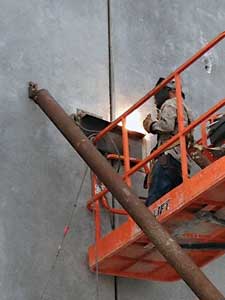 |
| (1) Steel is arc welded to the steel embedded in the tilt-up wall sections. Note that a raker shore is used to support the wall sections until they are fastened together and to the roof. |
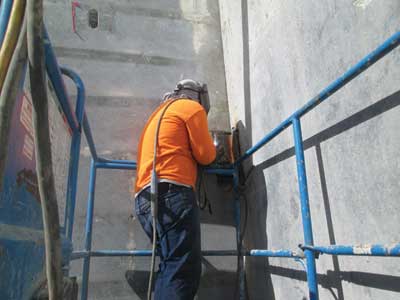 |
| (2) A steel angle is welded to the steel in the wall sections to fasten them in the corners. This apparently was not done in the A/B corner of the Home Depot where this fire occurred. (Photos by Bill Gustin.) |
When designing a tilt-up wall system, engineers must take into account not only the various loads applied to the structure but, equally as important, the reactions of this large volume, dynamic space, its components, and its connections as they are subjected to normal environmental and thermal conditions. Although rigidly tied together, the components must be able to move, contract, and expand. All structural members and connections must work together to create stability, ensuring that the structure is not solely dependent on one member. Concrete is inherently fire resistant; however, the tilt-up wall system is also dependent on fire protection systems or coatings to protect its structural components. It is this redundancy that reinforces the entire wall system and aims to prevent deterioration and a catastrophic collapse.
When approaching the building and establishing the proper fireground tactics for the conditions at hand, fire officers must perform a proper size-up, and care must be given to the location, extent, and condition of the fire; locating the fire department connections; panel distortion; separation or spalling as well as changes to the roof structure, establishing collapse zones, and proper apparatus placement. This is important because, as stated previously, the embedments, weldments, and rigid connections that hold the structure together are designed for normal loading conditions and environmental changes and not to withstand heavy fire conditions. It is important to understand that structural members supporting a roof, such as trusses, girders, and beams, may rest on a column or wall with as little as four inches of bearing surface.
Roof structural members bolted or welded at their bearing points are restrained from elongating when they are heated or cooled unevenly and have a tendency to warp and distort, which may cause them to pull off their bearing or connection points. Additionally, tilt-up wall sections can fail to the point of collapse when the concrete spalls as it reduces the strength of the embedments and weldments tying the wall sections together.
The Home Depot fire in South Miami-Dade County is a great example of the deterioration of a tilt-up structural system caused by extreme heat. This large-volume building was approximately 100,000 square feet and about 30 feet high. It was constructed using a tilt-up wall system for the exterior walls and an interior structural steel system that would assist in supporting a steel roof system with clear, interior, simply supported spans of up to 45 feet.
The roof system was comprised of steel open web joists topped by an expanded metal deck, lightweight insulating concrete, and a modified bitumen roof membrane. The open-web, steel roof girders were supported and attached to the interior steel columns and the tilt-up walls and spanned between the B and D sides. The open web joists were supported and attached to the girders and the tilt-up walls between the A and C sides of the building. The roof system was attached to the joists and an angle iron that runs the length of the B and D sides. As is typical, the tilt-up walls were stitched together vertically using steel embedments and welded plates, leaving about a one-inch caulked seam for expansion between panels.
After the fire and on review of the structure’s condition, one can conclude that while the fire sprinkler system was shut down for repairs, the fire quickly intensified because of the products stored on the rack and, as the fire progressed, the extreme heat created movement and expansion within the tilt-up structure. Soon thereafter, the heat and fire impingement on the girder truss caused the girder to deform and push outward toward the A side of the building. The force created by this distortion moved the joists attached to it toward the A side and applied a lateral force to the top of the tilt-up wall at the A /B corner. At that point, the A wall separated outward and away from the B wall.
As the fire continued, but prior to extinguishment, the A/B corner began to return to its original position, which may have caused the reformation of the wall. During the later stages of the fire, the joists directly behind the girder sagged; as they did, they pulled the already heated girder back, therefore, relieving some of the lateral forces on the A wall. Also, as the walls began to cool, they contracted and moved back inward.
Now, why did the A/B corner pull away and not affect the walls adjacent to it? On review of the A/B corner, from the inside, it was noted that there were no corner embedments or angles to tie the corner together; therefore, the simple connection of the metal deck to the angle iron on the B wall did not withstand the later forces imposed by the bar joists.
FERNANDO R. FERNANDEZ is a 30-year veteran of the Miami-Dade County (FL) Fire/Rescue Department from which he retired as assistant chief, second in command. He is a licensed general contractor and founded a company specializing in concrete construction. He taught high-rise operations to area departments in Las Vegas. He was a Federal Emergency Management Agency/Department of Defense logistical manager, a technical and logistics team manager and rescue specialist for Miami-Dade Task Force One, and a member of the United States Agency for International Development/Office of U.S. Foreign Disaster Assistance response team. He operated at the following urban search and rescue deployments: Punta Gorda (FL) Hurricane Charlie (2004), New York’s World Trade Center Attack (2001), El Salvador earthquake (2001), Turkey earthquake (1999), Colombia earthquake (1999), and Oklahoma City bombing (1995).
More Fire Engineering Issue Articles
Fire Engineering Archives
